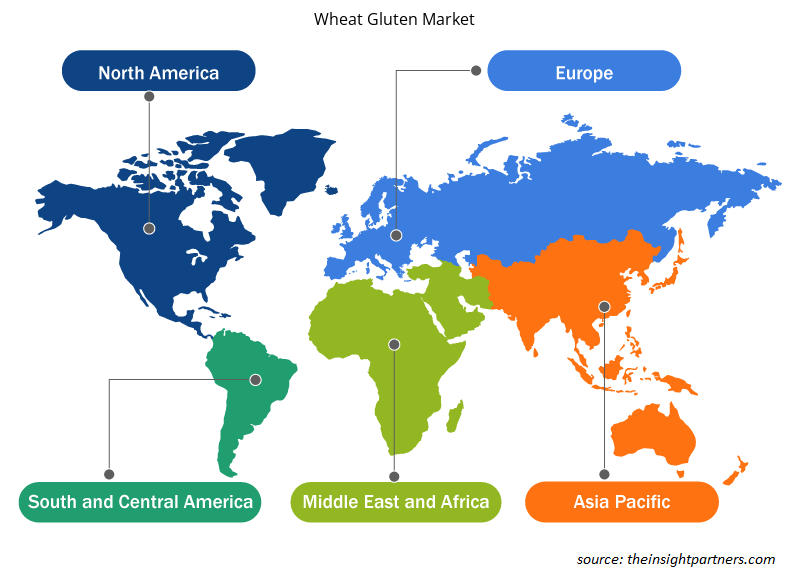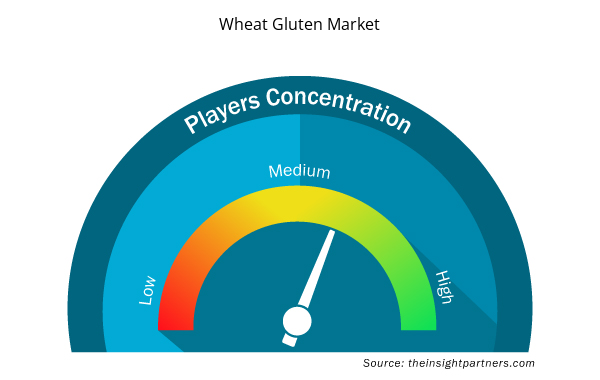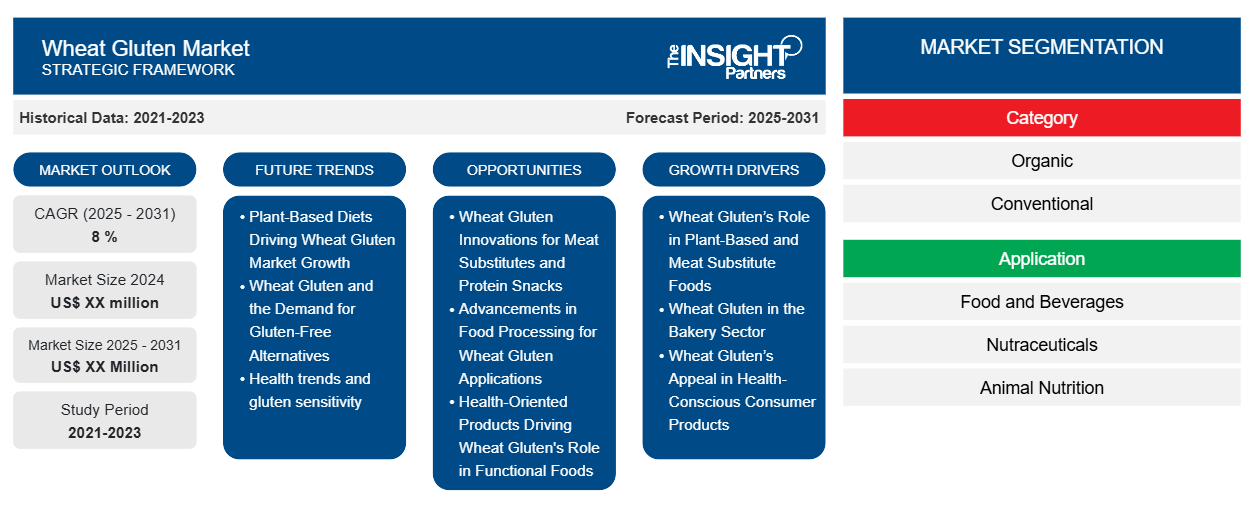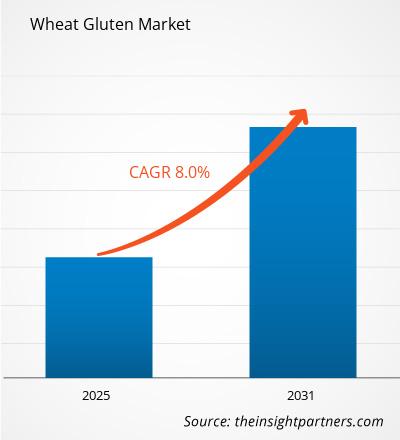Se espera que el mercado de gluten de trigo registre una CAGR del 8 % entre 2023 y 2031, con un tamaño de mercado que se expandirá de US$ XX millones en 2023 a US$ XX millones en 2031.
El informe está segmentado por categoría (orgánico, convencional). El informe presenta además un análisis basado en la aplicación (alimentos y bebidas, nutracéuticos, nutrición animal, otros). El análisis global se desglosa aún más a nivel regional y por países principales. En términos geográficos, el mercado se divide en América del Norte, Europa, Asia Pacífico, Medio Oriente y África, y América del Sur y Central. El informe ofrece el valor en USD para el análisis y los segmentos anteriores.
Propósito del Informe
El informe Wheat Gluten Market de The Insight Partners tiene como objetivo describir el panorama actual y el crecimiento futuro, los principales factores impulsores, los desafíos y las oportunidades. Esto proporcionará información a diversas partes interesadas del negocio, como:
- Proveedores/fabricantes de tecnología: Para comprender la dinámica cambiante del mercado y conocer las oportunidades potenciales de crecimiento, lo que les permitirá tomar decisiones estratégicas informadas.
- Inversionistas: Realizar un análisis exhaustivo de tendencias sobre la tasa de crecimiento del mercado, las proyecciones financieras del mercado y las oportunidades que existen en toda la cadena de valor.
- Órganos reguladores: Regular las políticas y vigilar las actividades del mercado con el objetivo de minimizar los abusos, preservar la confianza de los inversores y defender la integridad y la estabilidad del mercado.
Segmentación del mercado del gluten de trigo
Categoría
- Orgánico
- Convencional
Solicitud
- Alimentos y bebidas
- Nutracéuticos
- Nutrición animal
- Otros
Personalice este informe según sus necesidades
Obtendrá personalización en cualquier informe, sin cargo, incluidas partes de este informe o análisis a nivel de país, paquete de datos de Excel, así como también grandes ofertas y descuentos para empresas emergentes y universidades.
- Obtenga las principales tendencias clave del mercado de este informe.Esta muestra GRATUITA incluirá análisis de datos, desde tendencias del mercado hasta estimaciones y pronósticos.
Factores impulsores del crecimiento del mercado del gluten de trigo
- El papel del gluten de trigo en los alimentos vegetales y sustitutos de la carne: la creciente tendencia hacia la venta al por mayor de alimentos vegetales está aumentando los requisitos de suministro de gluten de trigo, que es rico en proteínas y tiene un uso versátil. Dado que los consumidores buscan sustitutos de la carne, el gluten de trigo ahora se utiliza de muchas maneras, incluso en forma de sustitutos de la carne y bocadillos ricos en proteínas, lo que ayuda al crecimiento del mercado.
- Gluten de trigo en el sector de la panadería: El sector de la panadería fomenta el crecimiento del mercado del gluten de trigo, ya que lo utiliza para mejorar la consistencia y la elasticidad de la masa. Con el aumento del consumo per cápita de pan y otros productos horneados en todo el mundo, se prevé que aumente la demanda de gluten de trigo, lo que contribuirá al crecimiento de su mercado.stretchability of dough. With the increase in the per capita consumption of bread and other baked products around the world, the requirement for wheat gluten is projected to grow, thereby aiding its market growth.
- El atractivo del gluten de trigo en los productos de consumo saludables: la conciencia de la gente sobre la salud ha aumentado de forma notable, por lo que es más probable que busquen recursos dietéticos que sean funcionales por naturaleza. Dado que el gluten de trigo es una fuente rica en proteínas y fibra, se ha producido un cambio hacia el desarrollo de productos más saludables, lo que a su vez genera nuevos cambios positivos en el mercado.
Tendencias futuras del mercado del gluten de trigo
- Las dietas basadas en plantas impulsan el crecimiento del mercado del gluten de trigo: existe un crecimiento considerable en la tendencia de las dietas basadas en plantas que lideran el mercado del gluten de trigo para su uso en sustitutos de la carne y alimentos enriquecidos con proteínas. Sin embargo, tal desarrollo es una respuesta al cambio de actitud del consumidor en el mercado hacia alimentos saludables y respetuosos con el medio ambiente, ampliando aún más el alcance del mercado e impulsando su crecimiento.
- El gluten de trigo y la demanda de alternativas sin gluten: las personas son cada vez más conscientes de los problemas de salud relacionados con el gluten, ya sea la enfermedad celíaca o la intolerancia al gluten, lo que facilita la definición del mercado objetivo para los productos sin gluten. Esta tendencia afecta la innovación y el comportamiento de los consumidores de los productores, lo que los lleva a pensar en formas de producir productos sin gluten y, al mismo tiempo, producir productos con gluten de trigo.
- Tendencias de salud y sensibilidad al gluten: las dietas sin gluten están ganando popularidad entre las personas alérgicas o sensibles al gluten. Por ello, los fabricantes están cambiando su enfoque para desarrollar productos con menor contenido de gluten para los consumidores que buscan productos bajos en gluten.
Oportunidades de mercado para el gluten de trigo
- Innovaciones a base de gluten de trigo para sustitutos de carne y snacks proteicos: A medida que más personas practican el vegetarianismo, surge la demanda de innovaciones alimentarias basadas en gluten de trigo, en particular para el desarrollo de sustitutos de carne y snacks ricos en proteínas. Esto se debe a que se fabrica fácilmente en formas texturizadas y contiene un alto porcentaje de proteínas, un aspecto que resulta atractivo para los fabricantes de alimentos que se dirigen a este grupo de consumidores.
- Avances en el procesamiento de alimentos para aplicaciones de gluten de trigo: Además, los avances que se están produciendo en el procesamiento de la industria alimentaria y las tecnologías de vanguardia brindan espacio para la invención de otros atributos del gluten de trigo. Estos pueden ser mejoras en las composiciones reales de pasteles, fideos, etc., lo que permitirá a los productores adaptarse a las cambiantes demandas del mercado de productos alimenticios limpios, saludables y funcionales.
- Los productos orientados a la salud impulsan el papel del gluten de trigo en los alimentos funcionales: con respecto a la cuestión de la demanda de productos alimenticios orientados a la salud, el mercado de alimentos funcionales está creciendo principalmente debido al cambio en el comportamiento del consumidor. Esto también se debe a que el gluten de trigo es una buena fuente de proteínas y fibra y, por lo tanto, se podrían desarrollar más productos orientados a la salud que lo incluyan como materia prima esencial en línea con las tendencias de salud emergentes.
Perspectivas regionales del mercado del gluten de trigo
Los analistas de Insight Partners explicaron en detalle las tendencias y los factores regionales que influyen en el mercado del gluten de trigo durante el período de pronóstico. Esta sección también analiza los segmentos y la geografía del mercado del gluten de trigo en América del Norte, Europa, Asia Pacífico, Oriente Medio y África, y América del Sur y Central.

- Obtenga datos regionales específicos para el mercado de gluten de trigo
Alcance del informe sobre el mercado del gluten de trigo
| Atributo del informe | Detalles |
|---|---|
| Tamaño del mercado en 2023 | XX millones de dólares estadounidenses |
| Tamaño del mercado en 2031 | US$ XX millones |
| CAGR global (2023 - 2031) | 8 % |
| Datos históricos | 2021-2022 |
| Período de pronóstico | 2024-2031 |
| Segmentos cubiertos | Por categoría
|
| Regiones y países cubiertos | América del norte
|
| Líderes del mercado y perfiles de empresas clave |
|
Densidad de los actores del mercado del gluten de trigo: comprensión de su impacto en la dinámica empresarial
El mercado del gluten de trigo está creciendo rápidamente, impulsado por la creciente demanda de los usuarios finales debido a factores como la evolución de las preferencias de los consumidores, los avances tecnológicos y una mayor conciencia de los beneficios del producto. A medida que aumenta la demanda, las empresas amplían sus ofertas, innovan para satisfacer las necesidades de los consumidores y aprovechan las tendencias emergentes, lo que impulsa aún más el crecimiento del mercado.
La densidad de actores del mercado se refiere a la distribución de las empresas o firmas que operan dentro de un mercado o industria en particular. Indica cuántos competidores (actores del mercado) están presentes en un espacio de mercado determinado en relación con su tamaño o valor total de mercado.
Las principales empresas que operan en el mercado del gluten de trigo son:
- Bryan W Nash y Sons Ltd.
- Cargill, Incorporada
- Corona Staerke
- Loryma GmbH
- Ingredientes de MGP
Descargo de responsabilidad : Las empresas enumeradas anteriormente no están clasificadas en ningún orden particular.

- Obtenga una descripción general de los principales actores clave del mercado del gluten de trigo
Puntos de venta clave
- Cobertura integral: el informe cubre de manera integral el análisis de productos, servicios, tipos y usuarios finales del mercado de gluten de trigo, proporcionando un panorama holístico.
- Análisis de expertos: el informe se compila sobre la base de un profundo conocimiento de expertos y analistas de la industria.
- Información actualizada: El informe asegura relevancia comercial debido a su cobertura de información reciente y tendencias de datos.
- Opciones de personalización: este informe se puede personalizar para satisfacer los requisitos específicos del cliente y adaptarse adecuadamente a las estrategias comerciales.
Por lo tanto, el informe de investigación sobre el mercado del gluten de trigo puede ayudar a abrir camino para descifrar y comprender el escenario de la industria y las perspectivas de crecimiento. Si bien puede haber algunas preocupaciones válidas, los beneficios generales de este informe tienden a superar las desventajas.
- Análisis histórico (2 años), año base, pronóstico (7 años) con CAGR
- Análisis PEST y FODA
- Tamaño del mercado Valor/volumen: global, regional, nacional
- Industria y panorama competitivo
- Conjunto de datos de Excel


- Intraoperative Neuromonitoring Market
- Analog-to-Digital Converter Market
- Embolization Devices Market
- Retinal Imaging Devices Market
- Data Annotation Tools Market
- Print Management Software Market
- Bioremediation Technology and Services Market
- Small Internal Combustion Engine Market
- Tortilla Market
- Medical Second Opinion Market

Report Coverage
Revenue forecast, Company Analysis, Industry landscape, Growth factors, and Trends

Segment Covered
This text is related
to segments covered.

Regional Scope
North America, Europe, Asia Pacific, Middle East & Africa, South & Central America

Country Scope
This text is related
to country scope.
Preguntas frecuentes
The report can be delivered in PDF/Word format, we can also share excel data sheet based on request.
Cargill Incorporated, Roquette Frères S.A, Royal Ingredients Group, Pioneer Industries Limited, Permolex Ltd, Z and F Sungold Corporation, Kroener Staerke, Agrana, Sacchetto S.p.A. and Co KG are the key players operating in the market
Based on geography, North America held the largest share of the wheat gluten market.
Significantly growing bakery industry, and rising demand for functional food are the major factors driving the wheat gluten market growth.
Increasing consumer awareness about gluten sensitivity is likely to remain the key trends in the market.
The Wheat Gluten Market is estimated to witness a CAGR of 8 % from 2023 to 2031
Trends and growth analysis reports related to Food and Beverages : READ MORE..
1. Bryan W Nash and Sons Ltd
2. Cargill, Incorporated
3. Kroener Staerke
4. Loryma GmbH
5. MGP Ingredients
6. Nugen Feeds and Foods
7. Pioneer Industries Limited
8. Royal Ingredients Group
9. Sacchetto S.p.A.
10. Tereos S.A.
The Insight Partners performs research in 4 major stages: Data Collection & Secondary Research, Primary Research, Data Analysis and Data Triangulation & Final Review.
- Data Collection and Secondary Research:
As a market research and consulting firm operating from a decade, we have published and advised several client across the globe. First step for any study will start with an assessment of currently available data and insights from existing reports. Further, historical and current market information is collected from Investor Presentations, Annual Reports, SEC Filings, etc., and other information related to company’s performance and market positioning are gathered from Paid Databases (Factiva, Hoovers, and Reuters) and various other publications available in public domain.
Several associations trade associates, technical forums, institutes, societies and organization are accessed to gain technical as well as market related insights through their publications such as research papers, blogs and press releases related to the studies are referred to get cues about the market. Further, white papers, journals, magazines, and other news articles published in last 3 years are scrutinized and analyzed to understand the current market trends.
- Primary Research:
The primarily interview analysis comprise of data obtained from industry participants interview and answers to survey questions gathered by in-house primary team.
For primary research, interviews are conducted with industry experts/CEOs/Marketing Managers/VPs/Subject Matter Experts from both demand and supply side to get a 360-degree view of the market. The primary team conducts several interviews based on the complexity of the markets to understand the various market trends and dynamics which makes research more credible and precise.
A typical research interview fulfils the following functions:
- Provides first-hand information on the market size, market trends, growth trends, competitive landscape, and outlook
- Validates and strengthens in-house secondary research findings
- Develops the analysis team’s expertise and market understanding
Primary research involves email interactions and telephone interviews for each market, category, segment, and sub-segment across geographies. The participants who typically take part in such a process include, but are not limited to:
- Industry participants: VPs, business development managers, market intelligence managers and national sales managers
- Outside experts: Valuation experts, research analysts and key opinion leaders specializing in the electronics and semiconductor industry.
Below is the breakup of our primary respondents by company, designation, and region:

Once we receive the confirmation from primary research sources or primary respondents, we finalize the base year market estimation and forecast the data as per the macroeconomic and microeconomic factors assessed during data collection.
- Data Analysis:
Once data is validated through both secondary as well as primary respondents, we finalize the market estimations by hypothesis formulation and factor analysis at regional and country level.
- Macro-Economic Factor Analysis:
We analyse macroeconomic indicators such the gross domestic product (GDP), increase in the demand for goods and services across industries, technological advancement, regional economic growth, governmental policies, the influence of COVID-19, PEST analysis, and other aspects. This analysis aids in setting benchmarks for various nations/regions and approximating market splits. Additionally, the general trend of the aforementioned components aid in determining the market's development possibilities.
- Country Level Data:
Various factors that are especially aligned to the country are taken into account to determine the market size for a certain area and country, including the presence of vendors, such as headquarters and offices, the country's GDP, demand patterns, and industry growth. To comprehend the market dynamics for the nation, a number of growth variables, inhibitors, application areas, and current market trends are researched. The aforementioned elements aid in determining the country's overall market's growth potential.
- Company Profile:
The “Table of Contents” is formulated by listing and analyzing more than 25 - 30 companies operating in the market ecosystem across geographies. However, we profile only 10 companies as a standard practice in our syndicate reports. These 10 companies comprise leading, emerging, and regional players. Nonetheless, our analysis is not restricted to the 10 listed companies, we also analyze other companies present in the market to develop a holistic view and understand the prevailing trends. The “Company Profiles” section in the report covers key facts, business description, products & services, financial information, SWOT analysis, and key developments. The financial information presented is extracted from the annual reports and official documents of the publicly listed companies. Upon collecting the information for the sections of respective companies, we verify them via various primary sources and then compile the data in respective company profiles. The company level information helps us in deriving the base number as well as in forecasting the market size.
- Developing Base Number:
Aggregation of sales statistics (2020-2022) and macro-economic factor, and other secondary and primary research insights are utilized to arrive at base number and related market shares for 2022. The data gaps are identified in this step and relevant market data is analyzed, collected from paid primary interviews or databases. On finalizing the base year market size, forecasts are developed on the basis of macro-economic, industry and market growth factors and company level analysis.
- Data Triangulation and Final Review:
The market findings and base year market size calculations are validated from supply as well as demand side. Demand side validations are based on macro-economic factor analysis and benchmarks for respective regions and countries. In case of supply side validations, revenues of major companies are estimated (in case not available) based on industry benchmark, approximate number of employees, product portfolio, and primary interviews revenues are gathered. Further revenue from target product/service segment is assessed to avoid overshooting of market statistics. In case of heavy deviations between supply and demand side values, all thes steps are repeated to achieve synchronization.
We follow an iterative model, wherein we share our research findings with Subject Matter Experts (SME’s) and Key Opinion Leaders (KOLs) until consensus view of the market is not formulated – this model negates any drastic deviation in the opinions of experts. Only validated and universally acceptable research findings are quoted in our reports.
We have important check points that we use to validate our research findings – which we call – data triangulation, where we validate the information, we generate from secondary sources with primary interviews and then we re-validate with our internal data bases and Subject matter experts. This comprehensive model enables us to deliver high quality, reliable data in shortest possible time.


 Obtenga una muestra gratuita de este informe
Obtenga una muestra gratuita de este informe